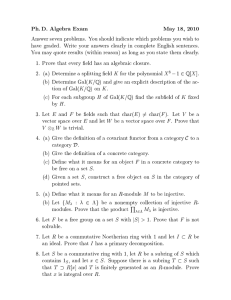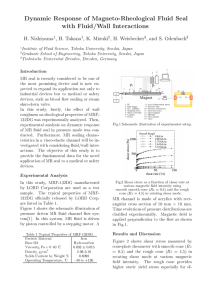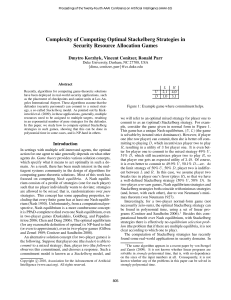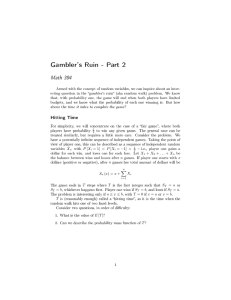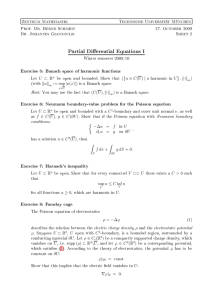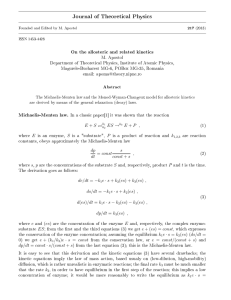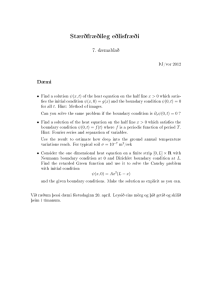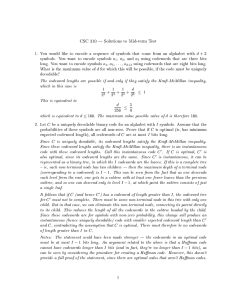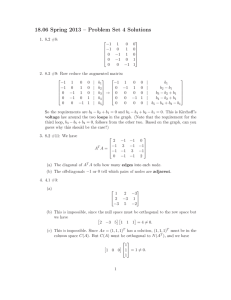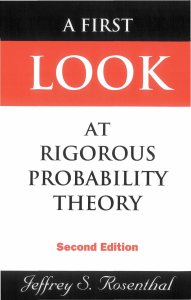к ь ср º л п я рьв с пс × л сжщ
реклама
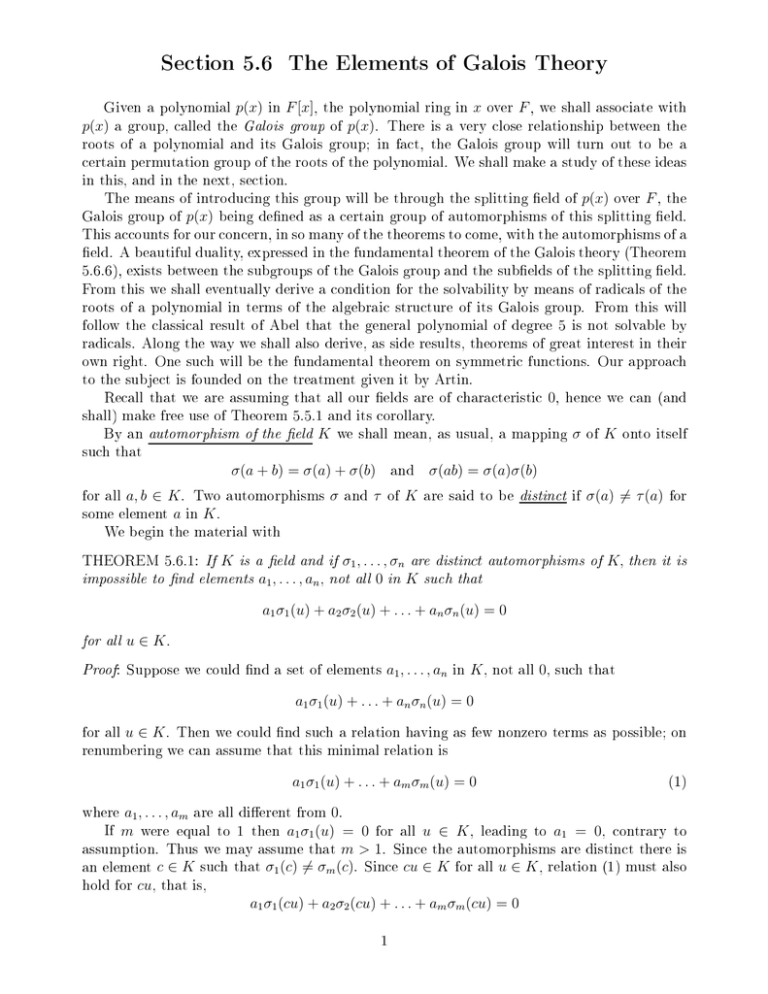
Setion 5.6
The Elements of Galois Theory
Given a polynomial p(x) in F [x], the polynomial ring in x over F , we shall assoiate with
p(x) a group, alled the Galois group of p(x). There is a very lose relationship between the
roots of a polynomial and its Galois group; in fat, the Galois group will turn out to be a
ertain permutation group of the roots of the polynomial. We shall make a study of these ideas
in this, and in the next, setion.
The means of introduing this group will be through the splitting eld of p(x) over F , the
Galois group of p(x) being dened as a ertain group of automorphisms of this splitting eld.
This aounts for our onern, in so many of the theorems to ome, with the automorphisms of a
eld. A beautiful duality, expressed in the fundamental theorem of the Galois theory (Theorem
5.6.6), exists between the subgroups of the Galois group and the subelds of the splitting eld.
From this we shall eventually derive a ondition for the solvability by means of radials of the
roots of a polynomial in terms of the algebrai struture of its Galois group. From this will
follow the lassial result of Abel that the general polynomial of degree 5 is not solvable by
radials. Along the way we shall also derive, as side results, theorems of great interest in their
own right. One suh will be the fundamental theorem on symmetri funtions. Our approah
to the subjet is founded on the treatment given it by Artin.
Reall that we are assuming that all our elds are of harateristi 0, hene we an (and
shall) make free use of Theorem 5.5.1 and its orollary.
By an automorphism of the eld K we shall mean, as usual, a mapping σ of K onto itself
suh that
σ(a + b) = σ(a) + σ(b) and σ(ab) = σ(a)σ(b)
for all a, b ∈ K . Two automorphisms σ and τ of K are said to be distint if σ(a) 6= τ (a) for
some element a in K .
We begin the material with
THEOREM 5.6.1: If K is a eld and if σ1 , . . . , σn are distinct automorphisms of K, then it is
impossible to nd elements a1 , . . . , an , not all 0 in K suh that
a1 σ1 (u) + a2 σ2 (u) + . . . + an σn (u) = 0
for all u ∈ K .
Proof: Suppose we ould nd a set of elements a1 , . . . , an in K , not all 0, suh that
a1 σ1 (u) + . . . + an σn (u) = 0
for all u ∈ K . Then we ould nd suh a relation having as few nonzero terms as possible; on
renumbering we an assume that this minimal relation is
a1 σ1 (u) + . . . + am σm (u) = 0
(1)
where a1 , . . . , am are all dierent from 0.
If m were equal to 1 then a1 σ1 (u) = 0 for all u ∈ K , leading to a1 = 0, ontrary to
assumption. Thus we may assume that m > 1. Sine the automorphisms are distint there is
an element c ∈ K suh that σ1 (c) 6= σm (c). Sine cu ∈ K for all u ∈ K , relation (1) must also
hold for cu, that is,
a1 σ1 (cu) + a2 σ2 (cu) + . . . + am σm (cu) = 0
1
for all u ∈ K . Using the hypothesis that the σ 's are automorphisms of K , this relation beomes
a1 σ1 (c)σ1 (u) + a2 σ2 (c)σ2 (u) + . . . + am σm (c)σm (u) = 0.
(2)
Multiplying relation (1) by σ1 (c) and subtrating the result from (2) yields
a2 (σ2 (c) − σ1 (c))σ2 (u) + . . . + am (σm (c) − σ1 (c))σm (u) = 0.
(3)
If we put
bi = ai (σi (c) − σ1 (c))
for i = 2, . . . , m, then the bi are in K,
bm = am (σm (c) − σ1 (c)) 6= 0,
sine am 6= 0, and σm (c) − σ1 (c) 6= 0 yet
b2 σ2 (u) + . . . + bm σm (u) = 0
for all u ∈ K . This produes a shorter relation, ontrary to the hoie made; thus the theorem
is proved. DEFINITION: If G is a group of automorphisms of K , then the xed eld of G is the set of all
elements a ∈ K suh that σ(a) = a for all σ ∈ G.
Note that this denition makes perfetly good sense even if G is not a group but is merely a
set of automorphisms of K . However, the xed eld of a set of automorphisms and that of the
group of automorphisms generated by this set (in the group of all automorphisms of K ) are equal
(Problem 1), hene we lose nothing by dening the onept just for groups of automorphisms.
Besides, we shall only be interested in the xed elds of groups of automorphisms.
Having alled the set, in the denition above, the xed eld of G, it would be nie if this
terminology were aurate. That it is we see in
LEMMA 5.6.1: The xed eld of G is a subeld of K .
Proof: Let a, b be in the xed eld of G. Thus for all σ ∈ G, σ(a) = a and σ(b) = b. But then
σ(a ± b) = σ(a) ± σ(b) = a ± b and σ(ab) = σ(a)σ(b) = ab;
hene a ± b and ab are again in the xed eld of G. If b 6= 0, then
σ(b−1 ) = σ(b)−1 = b−1 ,
hene b−1 also falls in the xed eld of G. Thus we have veried that the xed eld of G is
indeed a subeld of K . We shall be onerned with the automorphisms of a eld whih behave in a presribed
manner on a given subeld.
DEFINITION: Let K be a eld and let F be a subeld of K . Then the group of automorphisms
of K relative to F , written G(K, F ), is the set of all automorphisms of K leaving every element
of F xed; that is, the automorphism σ of K is in G(K, F ) if and only if σ(α) = α for every
α ∈ F.
2
It is not surprising, and is quite easy to prove
LEMMA 5.6.2: G(K, F ) is a subgroup of the group of all automorphisms of K .
We leave the proof of this lemma to the reader. One remark: K ontains the eld of rational
numbers F0 , sine K is of harateristi 0, and it is easy to see that the xed eld of any group
of automorphisms of K , being a eld, must ontain F0 . Hene, every rational number is left
xed by every automorphism of K .
We pause to examine a few examples of the onepts just introdued.
EXAMPLE 5.6.1: Let K be the eld of omplex numbers and let F be the eld of real numbers.
We ompute G(K, F ). If σ is any automorphism of K , sine i2 = −1,
σ(i)2 = σ(i2 ) = σ(−1) = −1,
hene σ(i) = ±i. If, in addition, σ leaves every real number xed, then for any a + bi where
a, b are real,
σ(a + bi) = σ(a) + σ(b)σ(i) = a ± bi.
Eah of these possibilities, namely the mapping
σ1 (a + bi) = a + bi and σ2 (a + bi) = a − bi
denes an automorphism of K, σ1 being the identity automorphism and σ2 omplex-onjugation.
Thus G(K, F ) is a group of order 2.
What is the xed eld of G(K, F )? It ertainly must ontain F , but does it ontain more?
If a + bi is in the xed eld of G(K, F ) then
a + bi = σ2 (a + bi) = a − bi,
whene b = 0 and a = a + bi ∈ F . In this ase we see that the xed eld of G(K, F ) is preisely
F itself.
EXAMPLE 5.6.2: Let F0 be the eld of rational numbers and let K = F0
the real ube root of 2. Every element in K is of the form
√
√
3
2 where 3 2 is
√
√
3
3
α0 + α1 2 + α2 ( 2)2 ,
where α0 , α1 , α2 are rational numbers. If σ is an automorphism of K , then
√
√
3
3
σ( 2)3 = σ(( 2)3 ) = σ(2) = 2,
√ hene σ 3 2 must also be a ube root of 2 lying in K . However, there is√ only
one real ube
√
3
root of 2, and sine K is a subeld of the real eld, we must have that σ 2 = 3 2. But then
√
√
√
√
3
3
3
3
σ(α0 + α1 2 + α2 ( 2)2 ) = α0 + α1 2 + α2 ( 2)2 ,
that is, σ is the identity automorphism of K . We thus see that G(K, F0 ) onsists only of the
identity map, and in this ase the xed eld of G(K, F0 ) is not F0 but is, in f act, larger, being
all of K .
EXAMPLE 5.6.3: Let F0 be the eld of rational numbers and let ω = e2πi/5 ; thus ω 5 = 1 and
ω satises the polynomial x4 + x3 + x2 + x + 1 over F0 . By the Eisenstein riterion one an
3
show that x4 + x3 + x2 + x + 1 is irreduible over F0 (see Problem 3). Thus K = F0 (ω) is of
degree 4 over F0 and every element in K is of the form α0 + α1 ω + α2 ω 2 + α3 ω 3 where all of
α0 , α1 α2 , and α3 are in F0 . Now, for any automorphism σ of K, σ(ω) 6= 1, sine σ(1) = 1, and
σ(ω)5 = σ(ω 5 ) = σ(1) = 1, whene σ(ω) is also a 5th root of unity. In onsequene, σ(ω) an
only be one of ω, ω 2, ω 3, or ω 4 . We laim that eah of these possibilities atually ours, for let
us dene the four mappings σ1 , σ2 , σ3 , and σ4 by
σi (α0 + α1 ω + α2 ω 2 + α3 ω 3) = α0 + α1 (ω i) + α2 (ω i)2 + α3 (ω i)3 ,
for i = 1, 2, 3, and 4. Eah of these denes an automorphism of K (Problem 4). Therefore,
sine σ ∈ G(K, F0 ) is ompletely determined by σ(ω), G(K, F0 ) is a group of order 4, with
σ1 as its unit element. In light of
σ22 = σ4 , σ23 = σ3 , σ24 = σ1 ,
G(K, F0 ) is a yli group of order 4. One an easily prove that the xed eld of G(K, F0 ) is
F0 itself (Problem 5). The subgroup A = {σ1 , σ4 } of G(K, F0 ) has as its xed eld the set of
all elements
α0 + α2 (ω 2 + ω 3 ),
whih is an extension of F0 of degree 2.
The examples, although illustrative, are still too speial, for note that in eah of them
G(K, F ) turned out to be a yli group. This is highly atypial for, in general, G(K, F )
need not even be abelian (see Theorem 5.6.3). However, despite their speialty, they do bring
ertain important things to light. For one thing they show that we must study the eet of the
automorphisms on the roots of polynomials and, for another, they point out that F need not
be equal to all of the xed eld of G(K, F ). The ases in whih this does happen are highly
desirable ones and are situations with whih we shall soon spend muh time and eort.
THEOREM 5.6.2: If K is a nite extension of F, then G(K, F ) is a nite group and its order,
o(G(K, F )) satises o(G(K, F )) ≤ [K : F ].
Proof: Let [K : F ] = n and suppose that u1 , . . . , un is a basis of K over F . Suppose that we an
nd n + 1 distint automorphisms σ1 , σ2 , . . . , σn+1 in G(K, F ). By the orollary to Theorem
4.3.3 the system of n homogeneous linear equations in the n + 1 unknowns x1 , . . . , xn+1 :
σ1 (u1 )x1 + σ2 (u1 )x2 + . . . + σn+1 (u1 )xn+1 = 0
..
.
σ1 (ui )x1 + σ2 (ui)x2 + . . . + σn+1 (ui)xn+1 = 0
..
.
σ1 (un )x1 + σ2 (un )x2 + . . . + σn+1 (un )xn+1 = 0
has a nontrivial solution (not all 0) x1 = a1 , . . . , xn+1 = an+1 in K . Thus
a1 σ1 (ui ) + a2 σ2 (ui) + . . . + an+1 σn+1 (ui ) = 0
for i = 1, 2, . . . , n.
4
(1)
Sine every element in F is left xed by eah σi and sine an arbitrary element t in K is of
the form t = α1 u1 + . . . + αn un with α1 , . . . , αn in F , then from the system of equations (1) we
get
a1 σ1 (t) + . . . + an+1 σn+1 (t) = 0
for all t ∈ K . But this ontradits the result of Theorem 5.6.1. Thus Theorem 5.6.2 has been
proved. Theorem 5.6.2 is of entral importane in the Galois theory. However, aside from its key role
there, it serves us well in proving a lassi result onerned with symmetri rational funtions.
This result on symmetri funtions in its turn will play an important part in the Galois theory.
First a few remarks on the eld of rational funtions in n-variables over a eld F . Let us
reall that in Setion 3.11 we dened the ring of polynomials in the n-variables x1 , . . . , xn over
F and from this dened the eld of rational funtions in x1 , . . . , xn , F (x1 , . . . , xn ), over F as
the ring of all quotients of suh polynomials.
Let Sn be the symmetri group of degree n onsidered to be ating on the set [1, 2, . . . , n];
for σ ∈ Sn and i an integer with 1 ≤ i ≤ n, let σ(i) be the image of i under σ . We an
make Sn at on F (x1 , . . . , xn ) in the following natural way: for σ ∈ Sn and r(x1 , . . . , xn ) ∈
F (x1 , . . . , xn ), dene the mapping whih takes r(x1 , . . . , xn ) onto r(xσ(1) , . . . , xσ(n) ). We shall
write this mapping of F (x1 , . . . , xn ) onto itself also as σ . It is obvious that these mappings
dene automorphisms of F (x1 , . . . , xn ). What is the xed eld of F (x1 , . . . , xn ) with respet to
Sn ? It onsists of all rational funtions r(x1 , . . . , xn ) suh that
r(x1 , . . . , xn ) = r(xσ(1) , . . . , xσ(n) )
for all σ ∈ Sn . But these are preisely those elements in F (x1 , . . . , xn ) whih are known as the
symmetri rational funtions. Being the xed eld of Sn they form a subeld of F (x1 , . . . , xn ),
alled the eld of symmetri rational funtions whih we shall denote by S . We shall be
onerned with three questions:
1. What is [F (x1 , . . . , xn ) : S]?
2. What is G(F (x1 , . . . , xn ), S )?
3. Can we desribe S in terms of some partiularly simple extension of F ?
We shall answer these three questions simultaneously.
We an expliitly produe in S some partiularly simple funtions onstruted from x1 , . . . , xn
known as the elementary symmetri funtions in x1 , . . . , xn . These are dened as follows:
a1 = x1 + x2 + . . . + xn =
n
X
i=1
a2 =
X
xi xj
i<j
a3 =
..
.
X
xi xj xk
i<j<k
an = x1 x2 . . . xn .
5
xi
That these are symmetri funtions is left as an exerise. For n = 2, 3 and 4 we write them out
exphitly below.
n=2
a1 = x1 + x2 .
a2 = x1 x2 .
n=3
a1 = x1 + x2 + x3 .
a2 = x1 x2 + x1 x3 + x2 x3 .
a3 = x1 x2 x3 .
n=4
a1 = x1 + x2 + x3 + x4 .
a2 = x1 x2 + x1 x3 + x1 x4 + x2 x3 + x2 x4 + x3 x4 .
a3 = x1 x2 x3 + x1 x2 x4 + x1 x3 x4 + x2 x3 x4 .
a4 = x1 x2 x3 x4 .
Note that when n = 2, x1 and x2 are the roots of the polynomial
t2 − a1 t + a2 ,
that when n = 3, x1 , x2 , and x3 are roots of
t3 − a1 t2 + a2 t − a3
and that when n = 4, x1 , x2 , x3 , and x4 are all roots of
t4 − a1 t3 − a2 t2 − a3 t + a4 .
Sine a1 , . . . , an are all in S, the eld F (a1 , . . . , an ) obtained by adjoining a1 , . . . , an to F
must lie in S. Our objetive is now twofold, namely, to prove
1. [F (x1 , . . . , xn ) : S] = n!.
2. S = F (a1 , . . . , an ).
Sine the group Sn is a group of automorphisms of F (x1 , . . . , xn ) leaving S xed,
Sn ⊂ G(F (x1 , . . . , xn ), S).
Thus, by Theorem 5.6.2,
[F (x1 , . . . , xn ) : S] ≥ o(G(F (x1 , . . . , xn ), S)) ≥ o(Sn ) = n!.
If we ould show that
[F (x1 , . . . , xn ) : F (a1 , . . . , an )] ≤ n!,
then, sine F (a1 , . . . , an ) is a subeld of S , we would have
n! ≥ [F (x1 , . . . , xn ) : F (a1 , . . . , an )] = [F (x1 , . . . , xn ) : S][S : F (a1 , . . . , an )] ≥ n!.
6
But then we would get that
[F (x1 , . . . , xn ) : S] = n!,
[S : F (a1 , . . . , an )] = 1
and so S = F (a1 , . . . , an ), and, nally,
Sn = G(F (x1 , . . . , xn ), S)
(this latter from the seond sentene of this paragraph). These are preisely the onlusions we
seek.
Thus, we merely must prove that
[F (x1 , . . . , xn ) : F (a1 , . . . , an )] ≤ n!.
To see how this settles the whole aair, note that the polynomial
p(t) = tn − a1 tn−1 + a2 tn−2 + . . . + (−1)n an ,
whih has oeients in F (a1 , . . . , an ), fators over F (x1 , . . . , xn ) as
p(t) = (t − x1 )(t − x2 ) . . . (t − xn ).
(This is in fat the origin of the elementary symmetri funtions.) Thus p(t), of degree n
over F (a1 , . . . , an ), splits as a produt of linear fators over F (x1 , . . . , xn ). It annot split over
a proper subeld of F (x1 , . . . , xn ) whih ontains F (a1 , . . . , an ) for this subeld would then
have to ontain both F and eah of the roots of p(t), namely, x1 , x2 , . . . , xn ; but then this
subeld would be all of F (x1 , . . . , xn ). Thus we see that F (x1 , . . . , xn ) is the splitting eld of
the polynomial
p(t) = tn − a1 tn−1 + . . . + (−1)n an
over F (a1 , . . . , an ). Sine p(t) is of degree n, by Theorem 5.3.2 we get
[F (x1 , . . . , xn ) : F (a1 , . . . , an )] ≤ n!.
Thus all our laims are established. We summarize the whole disussion in the basi and
important result
THEOREM 5.6.3: Let F be a eld and let F (x1 , . . . , xn ) be the eld of rational funtions in
x1 , . . . , xn over F. Suppose that S is the eld of symmetri rational funtions; then
1. [F (x1 , . . . , xn ) : S] = n!.
2. G(F (x1 , . . . , xn ), S) = Sn , the symmetri group of degree n.
3. If a1 , . . . , an are the elementary symmetri funtions in x1 , . . . , xn , then
S = F (a1 , a2 , . . . , an ).
4. F (x1 , . . . , xn ) is the splitting eld over F (a1 , . . . , an ) = S of the polynomial
tn − a1 tn−1 + a2 tn−2 + . . . + (−1)n an .
7
We mentioned earlier that given any integer n it is possible to onstrut a eld and a
polynomial of degree n over this eld whose splitting eld is of maximal possible degree, n!,
over this eld. Theorem 5.6.3 expliitly provides us with suh an example for if we put S =
F (a1 , . . . , an ), the rational funtion eld in n variables a1 , . . . , an and onsider the splitting eld
of the polynomial tn − a1 tn−1 + a2 tn−2 + . . . + (−1)n an over S then it is of degree n! over S .
Part 3 of Theorem 5.6.3 is a very lassial theorem. It asserts that a symmetri rational
funtion in n variables is a rational funtion in the elementary symmetri funtions of these
variables. This result an even be sharpened to: A symmetri polynomial in n variables is a
polynomial in their elementary symmetri funtions (see Problem 7). This result is known as
the theorem on symmetri polynomials.
In the examples we disussed of groups of automorphisms of elds and of xed elds under
suh groups, we saw that it might very well happen that F is atually smaller than the whole
xed eld of G(K, F ). Certainly F is always ontained in this eld but need not ll it out.
Thus to impose the ondition on an extension K of F that F be preisely the xed eld of
G(K, F ) is a genuine limitation on the type of extension of F that we are onsidering. It is in
this kind of extension that we shall be most interested.
DEFINITION: K is a normal extension of F if K is a nite extension of F suh that F is the
xed eld of G(K, F ).
Another way of saying the same thing: If K is a normal extension of F, then every element
in K whih is outside F is moved by some element in G(K, F ). In the examples disussed,
Examples 5.6.1 and 5.6.3 were normal extensions whereas Example 5.6.2 was not.
An immediate onsequene of the assumption of normality is that it allows us to alulate
with great auray the size of the xed eld of any subgroup of G(K, F ) and, in particular,
to sharpen Theorem 5.6.2 from an inequality to an equality.
THEOREM 5.6.4: Let K be a normal extension of F and let H be a subgroup of G(K, F ); let
KH = {x ∈ K | σ(x) = x f or all σ ∈ H}
be the xed eld of H. Then
1. [K : KH ] = o(H).
2. H = G(K, KH ).
(In partiular, when H = G(K, F ), [K : F ] = o(G(K, F )).)
Proof: Sine every element in H leaves KH elementwise xed, ertainly H ⊂ G(K, KH ). By
Theorem 5.6.2 we know that
[K : KH ] ≥ o(G(K, KH ));
and sine o(G(K, KH )) ≥ o(H) we have the inequalities
[K : KH ] ≥ o(G(K, KH )) ≥ o(H).
If we ould show that [K : KH ] = o(H), it would immediately follow that o(H) = o(G(K, KH ))
and as a subgroup of G(K, KH ) having order that of G(K, KH ), we would obtain that H =
G(K, KH ). So we must merely show that [K : KH ] = o(H) to prove everything.
By Theorem 5.5.1 there exists an a ∈ K suh that K = KH (a); this a must therefore satisfy
an irreduible polynomial over KH of degree m = [K : KH ] and no nontrivial polynomial
8
of lower degree (Theorem 5.1.3). Let the elements of H be σ1 , σ2 , . . . , σh , where σ1 is the
identity of G(K, F ) and where h = o(H). Consider the elementary symmetri funtions of
a = σ1 (a), σ2 (a), . . . , σh (a), namely,
α1 = σ1 (a) + σ2 (a) + . . . + σh (a) =
h
X
σi (a)
i=1
α2 =
X
..
.
i<j
σi (a)σj (a)
αh = σ1 (a)σ2 (a) . . . σh (a).
Eah αi is invariant under every σ ∈ H . (Prove!) Thus, by the denition of KH , α1 , α2 , . . . , αh
are all elements of KH . However, a (as well as σ2 (a), . . . , σh (a)) is a root of the polynomial
p(x) = (x − σ1 (a))(x − σ2 (a)) . . . (x − σh (a)) = xh − α1 xh−1 + α2 xh−2 + . . . + (−1)h αh
having oeients in KH . By the nature of a, this fores
h ≥ m = [K : KH ],
whene o(H) ≥ [K : KH ]. Sine we already know that o(H) ≤ [K : KH ] we obtain o(H) =
[K : KH ], the desired onlusion. When H = G(K, F ), by the normality of K over F, KH = F ; onsequently for this
partiular ase we read o the result [K : F ] = o(G(K, F )).
We are rapidly nearing the entral theorem of the Galois theory. What we still lak is the
relationship between splitting elds and normal extensions. This gap is lled by
THEOREM 5.6.5: K is a normal extension of F if and only if K is the splitting eld of some
polynomial over F .
Proof: In one diretion the proof will be highly reminisent of that of Theorem 5.6.4.
Suppose that K is a normal extension of F ; by Theorem 5.5.1, K = F (a). Consider the
polynomial
p(x) = (x − σ1 (a))(x − σ2 (a)) . . . (x − σn (a))
over K , where σ1 , σ2 , . . . , σn are all the elements of G(K, F ). Expanding p(x) we see that
p(x) = xn − α1 xn−1 + α2 xn−2 + . . . + (−1)n αn
where α1 , . . . , αn are the elementary symmetri funtions in a = σ1 (a), σ2 (a), . . . , σn (a). But
then α1 , . . . , αn are eah invariant with respet to every σ ∈ G(K, F ), whene by the normality
of K over F , must all be in F . Therefore, K splits the polynomial p(x) ∈ F [x] into a produt
of linear fators. Sine a is a root of p(x) and sine a generates K over F, a an be in no proper
subeld of K whih ontains F . Thus K is the splitting eld of p(x) over F .
Now for the other diretion; it is a little more ompliated. We separate o one piee of its
proof in
LEMMA 5.6.3: Let K be the splitting eld of f (x) in F [x] and let p(x) be an irreduible fator
of f (x) in F [x]. If the roots of p(x) are α1 , . . . , αr , then for eah i there exis ts an automorphism
σi in G(K, F ) suh that σi (α1 ) = αi .
9
Proof: Sine every root of p(x) is a root of f (x), it must lie in K . Let α1 , αi be any two roots of
p(x). By Theorem 5.3.3, there is an isomorphism τ of F1 = F (α1 ) onto F1′ = F (αi ) taking α1
onto αi and leaving every element of F xed. Now K is the splitting eld of f (x) onsidered as
a polynomial over F1 ; likewise, K is the splitting eld of f (x) onsidered as a polynomial over
F1′ . By Theorem 5.3.4 there is an isomorphism σi of K onto K (thus an automorphism of K )
oiniding with τ on F1 . But then σi (α1 ) = τ (α1 ) = αi and σi leaves every element of F xed.
This is, of ourse, exatly what Lemma 5.6.3 laims. We return to the ompletion of the proof of Theorem 5.6.5. Assume that K is the splitting
eld of the polynomial f (x) in F [x]. We want to show that K is normal over F . We proeed
by indution on [K : F ], assuming that for any pair of elds K1 , F1 of degree less than [K : F ]
that whenever K1 is the splitting eld over F1 of a polynomial in F1 [x], then K1 is normal over
F1 .
If f (x) ∈ F [x] splits into linear fators over F , then K = F, whih is ertainly a normal
extension of F . So, assume that f (x) has an irreduible fator p(x) ∈ F [x] of degree r > 1. The
r distint roots α1 , α2 , . . . , αr of p(x) all lie in K and K is the splitting eld of f (x) onsidered
as a polynomial over F (α1 ). Sine
[K : F (α1 )] =
[K : F ]
n
= < n,
[F (α1 ) : F ]
r
by our indution hypothesis K is a normal extension of F (α1 ).
Let θ ∈ K be left xed by every automorphism σ ∈ G(K, F ); we would like to show that θ
is in F. Now, any automorphism in G(K, F (α1 )) ertainly leaves F xed, hene leaves θ xed;
by the normality of K over F (α1 ), this implies that θ is in F (α1 ). Thus
θ = λ0 + λ1 α1 + λ2 α12 + . . . + λr−1 α1r−1
where λ0 , . . . , λr−1 ∈ F.
(1)
By Lemma 5.6.3 there is an automorphism σi of K, σi ∈ G(K, F ), suh that σi (α1 ) = αi ;
sine this σi leaves θ and eah λj xed, applying it to (1) we obtain
θ = λ0 + λ1 αi + λ2 αi2 + . . . + λr−1 αir−1
for i = 1, 2, . . . , r.
Thus the polynomial
q(x) = λr−1 xr−1 + λr−2 xr−2 + . . . + λ1 x + (λ0 − θ)
in K[x], of degree at most r − 1, has the r distint roots α1 , α2 , . . . , αr . This an only happen
if all its oeients are 0; in partiular, λ0 − θ = 0 whene θ = λ0 so is in F . This ompletes
the indution and proves that K is a normal extension of F . Theorem 5.6.5 is now ompletely
proved. DEFINITION: Let f (x) be a polynomial in F [x] and let K be its splitting eld over F . The
Galois group of f (x) is the group G(K, F ) of all the automorphisms of K, leaving every element
of F xed.
Note that the Galois group of f (x) an be onsidered as a group of permutations of its
roots, for if α is a root of f (x) and if σ ∈ G(K, F ) then σ(α) is also a root of f (x).
We now ome to the result known as the fundamental theorem of Galois theory. It sets up a
one-to-one orrespondene between the subelds of the splitting eld of f (x) and the subgroups
10
of its Galois group. Moreover, it gives a riterion that a subeld of a normal extension itself be
a normal extension of F . This fundamental theorem will be used in the next setion to derive
onditions for the solvability by radials of the roots of a polynomial.
THEOREM 5.6.6: Let f (x) be a polynomial in F [x], K its splitting eld over F, and G(K, F )
its Galois group. For any subeld T of K whih ontains F let
G(K, T ) = {σ ∈ G(K, F ) | σ(t) = t f or every t ∈ T }
and for any subgroup H of G(K, F ) let
KH = {x ∈ K | σ(x) = x f or every σ ∈ H}.
Then the assoiation of T with G(K, T ) sets up a one-to-one orrespondene of the set of
subelds of K whih ontain F onto the set of subgroups of G(K, F ) suh that
1. T = KG(K,T ) .
2. H = G(K, KH ).
3. [K : T ] = o(G(K, T )), [T : F ] =index of G(K, T ) in G(K, F ).
4. T is a normal extension of F if and only if G(K, T ) is a normal subgroup of G(K, F ).
5. When T is a normal extension of F , then G(T, F ) is isomorphi to
G(K, F )/G(K, T ).
Proof: Sine K is the splitting eld of f (x) over F it is also the splitting eld of f (x) over any
subeld T whih ontains F, therefore, by Theorem 5.6.5, K is a normal extension of T . Thus,
by the denition of normality, T is the xed eld of G(K, T ), that is, T = KG(K,T ) , proving 1.
Sine K is a normal extension of F , by Theorem 5.6.4, given a subgroup H of G(K, F ),
then H = G(K, KH ), whih is the assertion of part 2. Moreover, this shows that any subgroup
of G(K, F ) arises in the form G(K, T ), whene the assoiation of T with G(K, T ) maps the
set of all subelds of K ontaining F onto the set of all subgroups of G(K, F ). That it is
one-to-one is lear, for, if G(K, T1 ) = G(K, T2 ) then, by part 1,
T1 = KG(K,T1 ) = KG(K,T2 ) = T2 .
Sine K is normal over T , again using Theorem 5.6.4, [K : T ] = o(G(K, T )); but then
o(G(K, F )) = [K : F ] = [K : T ][T : F ] = o(G(K, T ))[T : F ],
whene
[T : F ] =
o(G(K, F ))
= index of G(K, T )
o(G(K, T ))
in G(K, F ). This is part 3.
The only parts whih remain to be proved are those whih pertain to normality. We rst
make the following observation. T is a normal extension of F if and only if for every σ ∈
G(K, F ), σ(T ) ⊂ T . Why? We know by Theorem 5.5.1 that T = F (a); thus if σ(T ) ⊂ T,
11
then σ(a) ∈ T for all σ ∈ G(K, F ). But, as we saw in the proof of Theorem 5.6.5, this implies
that T is the splitting eld of
Y
p(x) =
(x − σ(a))
σ∈G(K,F )
whih has oeients in F . As a splitting eld, T , by Theorem 5.6.5, is a normal extension of
F . Conversely, if T is a normal extension of F , then T = F (a), where the minimal polynomial
of a, p(x), over F has all its roots in T (Theorem 5.6.5). However, for any σ ∈ G(K, F ), σ(a)
is also a root of p(x), whene σ(a) must be in T . Sine T is generated by a over F, we get that
σ(T ) ⊂ T for every σ ∈ G(K, F ).
Thus T is a normal extension of F if and only if for any σ ∈ G(K, F ), τ ∈ G(K, T ) and
t ∈ T, σ(t) ∈ T and so τ (σ(t)) = σ(t); that is, if and only if σ −1 τ σ(t) = t. But this says that
T is normal over F if and only if σ −1 G(K, T )σ ⊂ G(K, T ) for every σ ∈ G(K, F ). This last
ondition being preisely that whih denes G(K, T ) as a normal subgroup of G(K, F ), we
see that part 4 is proved.
Finally, if T is normal over F , given σ ∈ G(K, F ), sine σ(T ) ⊂ T, σ indues an automorphism σ∗ of T dened by σ∗ (t) = σ(t) for every t ∈ T . Beause σ∗ leaves every element of F
xed, σ∗ must be in G(T, F ). Also, as is evident, for any σ, ψ ∈ G(K, F ), (σψ)∗ = σ∗ ψ∗ whene
the mapping of G(K, F ) into G(T, F ) dened by σ → σ∗ is a homomorphism of G(K, F ) into
G(T, F ). What is the kernel of this homomorphism? It onsists of all elements σ in G(K, F )
suh that σ∗ is the identity map on T . That is, the kernel is the set of all σ ∈ G(K, F ) suh
that t = σ∗ (t) = σ(t); by the very denition, we get that the kernel is exatly G(K, T ). The
image of G(K, F ) in G(T, F ), by Theorem 2.7.1 is isomorphi to G(K, F )/G(K, T ), whose
order is
o(G(K, F ))/o(G(K, T )) = [T : F ] (by part 3) = o(G(T, F )) (by Theorem 5.6.4).
Thus the image of G(K, F ) in G(T, F ) is all of G(T, F ) and so we have G(T, F ) isomorphi
to G(K, F )/G(K, T ). This nishes the proof of part 5 and thereby ompletes the proof of
Theorem 5.6.6. 12
